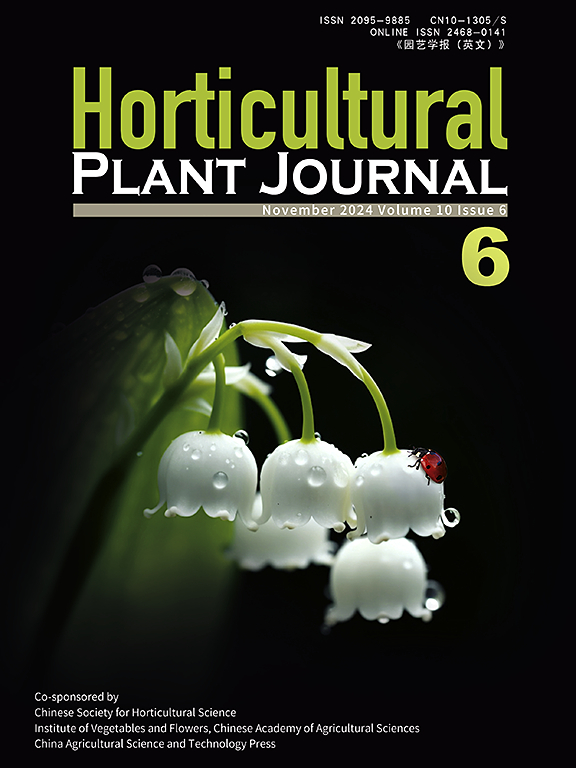芥菜异源多倍体硫代葡萄糖苷基因同源物的时空和亚基因组表达动态及调控差异
IF 6.2
1区 农林科学
Q1 HORTICULTURE
引用次数: 0
摘要
植物硫代葡萄糖苷(GSLs)因其在植物防御机制和癌症预防中的重要作用而受到广泛关注。然而,芥菜(Brassica juncea)表型变异的基因表达特征和机制,特别是在关键的蔬菜和油籽品种中,仍未得到充分研究。本研究研究了芥菜异源多倍体GSL代谢调控基因的保留、时空表达和亚基因组表达动态。我们的研究结果表明,拟南芥GSL基因(HAGG)的同源物与其他基因相比优先保留在芥菜基因组中。大多数HAGG基因(76.5%)在所有组织中表达,而其余基因则表现出组织特异性表达模式。大多数同源对(54.09%)表现出平衡的表达水平,而其余同源对在叶和茎中表现出明显的A基因组优势。值得注意的是,两个GRT2同源物Bju.GTR2。A03和Bju.GTR2。B06在GSL积累中表现出调控差异。Bju.GTR2共显性等位基因特异性标记。A03和Bju.GTR2。B06与它们各自的数量性状位点(QTL)共定位,与GSL含量共分离,证实了QTL定位结果。此外,GSL含量与菌核病抗性呈显著相关。对HAGG基因功能的预测进一步证实了它们的功能差异。本研究为提高芥菜在整个植物或特定组织中的GSL含量奠定了基础,为将来芥菜在农业和防癌方面的应用奠定了基础。本文章由计算机程序翻译,如有差异,请以英文原文为准。
Spatiotemporal and subgenome expression dynamics and regulatory divergence of the glucosinolate gene homologs in the allopolyploid Brassica juncea
Plant glucosinolates (GSLs) have attracted considerable attention due to their significant roles in plant defense mechanisms and cancer prevention. However, the gene expression characteristics and mechanisms underlying phenotypic variations in Brassica juncea , particularly in key vegetable and oilseed varieties, remain largely unexplored. This study examined the retention and the spatiotemporal expression and subgenome expression dynamics of duplicated genes predicted to regulate GSL metabolism in the allopolyploid B. juncea . Our findings reveal that homologs of Arabidopsis GSL genes (HAGG) are preferentially retained in the B. juncea genome compared to other genes. Most HAGG genes (76.5 %) were expressed across all tissues, while the remainders exhibited tissue-specific expression patterns. A majority of homoeologous pairs (54.09 %) demonstrated balanced expression levels, whereas the rest showed a pronounced A-genome dominance in leaves and stems. Notably, two GRT2 homologs, Bju.GTR2.A03 and Bju.GTR2.B06 , which exhibit regulatory divergence in GSL accumulation, were identified. Co-dominant allele-specific markers developed for Bju.GTR2.A03 and Bju.GTR2.B06 colocalized with their respective quantitative trait loci (QTLs) and co-segregated with GSL content, corroborating the results of QTL mapping. Furthermore, GSL content was significantly correlated with resistance to Sclerotinia sclerotiorum . Predictions regarding the functions of HAGG genes further validated their functional divergence. This study provides a foundation for enhancing GSL content in whole plants or specific tissues, facilitating future applications in agriculture and cancer prevention in B. juncea .
求助全文
通过发布文献求助,成功后即可免费获取论文全文。
去求助
来源期刊

Horticultural Plant Journal
Environmental Science-Ecology
CiteScore
9.60
自引率
14.00%
发文量
293
审稿时长
33 weeks
期刊介绍:
Horticultural Plant Journal (HPJ) is an OPEN ACCESS international journal. HPJ publishes research related to all horticultural plants, including fruits, vegetables, ornamental plants, tea plants, and medicinal plants, etc. The journal covers all aspects of horticultural crop sciences, including germplasm resources, genetics and breeding, tillage and cultivation, physiology and biochemistry, ecology, genomics, biotechnology, plant protection, postharvest processing, etc. Article types include Original research papers, Reviews, and Short communications.
 求助内容:
求助内容: 应助结果提醒方式:
应助结果提醒方式:


